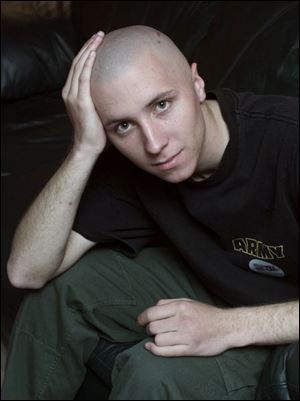
How's come they talk with an accent in northwest Ohio?
12/28/2001
Chris Mitro of Perrysburg, who is in the Army National Guard, heard his share of accents from across the country while he was stationed at Fort Benning, Ga.
When PFC Chris Mitro found himself on active military duty in September at Fort Benning, Ga., his newly shaved head rang with every kind of American English: Arkansas drawl, California surfer, a South Dakota clip, even Caribbean “Bob Marley talk.”
“I'm from Perrysburg, so I wasn't very noticeable. But we had some real standouts there, man,” the 20-year-old Army National Guard member said. “Imagine inner-city Texas.”
Even though he might not have stood out, if you're born and raised in good ol' Toledo, you have an accent.
“Everybody has an accent. There's no such thing as `pure American English,'” said University of Toledo linguistics professor Dorothy Siegel. “People around here think we're the standard, that everybody else in America talks the way we do.”
That overall sameness may serve a social purpose, she said - it helps us know who is one of us, and who is an outsider. It provides clues about the speaker's economic class, education, age, ethnicity, and race.
Varied accents run counter to popular cultural dictates on which clothes, cars, perfumes, or computers “everyone” should buy. Even as Americans strive to dress, smell, and shop the same, their speech makes them unique.
“People used to worry the American English was going homogeneous, but that's proven a myth,” the linguist said. “Just turn on the TV, and hear Peter Jennings say `out' [as] `oot.' He's Canadian. Dan Rather's from Texas, he can't hide that after all these years. Judy Woodruff is definitely southern.”
Research says regional accents are growing stronger. The Telsur Project at the University of Pennsylvania Linguistics Laboratory has spent six years studying and recording American dialects, using computers to take apart vowels, intonation, and other patterns.
The results, drawn onto a map, show Toledo on the border of two major dialect groups: the Midland North, and the Great Lakes Cities Shift. It's all in the E's and O's, the documents say, explaining it all with “minimal pairs” and “fronted checked /ow/'s” and other technical terms. Do you pronounce “cot” and “caught” the same way? Compare your “boat” with “about.” Your O “may be northern or Midwestern. And near Findlay, some “South Midland” slips in too.
The Penn study, called “Phonological Atlas of North America,” is posted on the Internet, with descriptions of regional patterns, evolutions, and sound samples to illustrate important points.
“Accents are fun,” Ms. Siegel said. “They can be a real ice-breaker if people are good-humored about them.
“You can play up your dialect, or play it down, change it like you change your clothes, to help you move more smoothly around people,” she said.
Some accents evolve. Others have change thrust upon them. Private Mitro said all the linguistic differences in his company seemed to vanish after a few weeks of infantry training.
“The military has one dialect, one set of slang,” he said. “Everyone uses that now. It's the only language we need.”